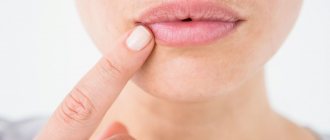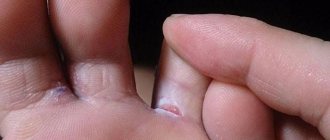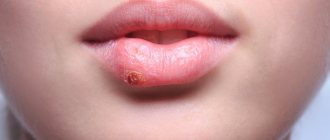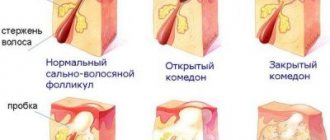Cheilitis is a disease and inflammation that is expressed by damage to the lips (“ cheilitis on the lips ”), more precisely, inflammation of the red border, the mucous membrane of the lips and (in some cases) the skin of the lips. According to medical classification, there are different types of cheilitis. For example, simple cheilitis (Cheilitis simplex, the most common form), angular cheilitis (Cheilitis angularis, or angular cheilitis , or seizure, or inflammation of the corners of the mouth). Cheilitis can be either an independent disease (for example, exfoliative cheilitis, glandular cheilitis, actinic cheilitis), or a symptom of other diseases (for example, atopic cheilitis , eczematous cheilitis ). There are more than twenty types or types of cheilitis.
Kinds
Depending on the causes of cheilitis, several types of this disease are conventionally distinguished. They differ not only in symptoms, but also in the method of treatment and prevention.
Primary
This group includes seizures caused by independent or primary causes, that is, inflammation does not develop against the background of any diseases in the body.
Glandular
Caused by congenital or acquired pathology of the minor salivary glands during life or their infection. This form occurs in people after 30 years of age, and the inflammation is usually located on the upper lip.
If left untreated, cracks and erosions in the skin develop, accompanied by unpleasant sensations when talking or eating.
Exfoliative
It is characterized by damage to only the red border of the lips and its peeling. There are two varieties of this type of cheilitis - dry (a crust forms on the lips, a feeling of dryness and burning occurs) and exudative (swelling and purulent formations develop). Exfoliative cheilosis is more often observed in women from 18 to 40 years old.
Contact allergic
Caused by an allergic reaction due to contact of an allergen with the skin of the lips. The form is characterized by swelling, severe redness and itching. If the source of irritation is not removed, the disease only gets worse. It can occur in both children and adults. In advanced cases, it can provoke allergic stomatitis.
Meteorological
It develops due to the body’s increased sensitivity to unfavorable climatic factors - wind, ultraviolet radiation or frost. As a rule, exudative manifestations form on the skin of the lips - small blisters filled with purulent fluid, and when they open, dense plaques form.
Secondary (symptomatic)
This group includes cheilitis caused by any systemic, infectious or fungal disease of the body. They usually develop against the background of the underlying disease, and external manifestations disappear during the recovery period.
Atopic
Some experts believe that this type is a special case of atopic dermatitis, since there are similar symptoms. Swelling of the lips and the surrounding area occurs, the inflammatory process affects a large area of the face. After the acute stage, severe peeling develops, which leads to the formation of deep cracks in the skin.
As a rule, it is observed with decreased immunity or long-term use of strong medications.
Eczematous
It develops exclusively against the background of eczema when the skin of the face is affected. In the acute stage, pronounced redness of the epidermis, burning and severe itching appear. Swelling may be accompanied by erythema and changes in skin structure. If left untreated, the disease becomes chronic. Among all types, it is the worst to respond to drug therapy.
Hypovitaminosis
Formed due to an acute lack or excess of vitamin B in the body (hypovitaminosis). Redness and cracking of the skin of the lips, swelling and inflammation of the surrounding area appear. Glossitis is often added to these symptoms. If treatment is not started in time, the disease becomes chronic, and deep vertical cracks appear not only in the corners, but all over the surface of the lips.
There are other types of primary and secondary cheilitis. Since it is not isolated as an independent disease, the form directly depends on the cause of its occurrence. For example, some dermatologists distinguish medicinal, mycotic (candida), bacterial and other types of cheilitis.
Prevention of cheilitis
Since the causes of the disease are extremely varied and often not reliably established, it is impossible to indicate a set of preventive measures to prevent lip damage. Prevention is possible only in certain cases, for example, excluding allergen-containing products from the diet if you are prone to atopic dermatitis. But in general, it is necessary to strengthen the body’s immune system to successfully suppress infections and treat diseases that manifest as lip diseases.
Request a consultation
Treatment of cheilitis on the lips
It is easy to diagnose cheilitis - usually a simple examination of the affected lips is enough for the doctor. The main difficulties arise when it is necessary to carry out a differential diagnosis of cheilitis with other diseases of the lips (leukoplakia or oncology); in this case, the doctor prescribes a histological examination.
Regardless of how cheilitis manifests itself, it must be treated comprehensively, taking into account the specific form of the pathology. General principles of therapy:
- In the early stages (dry lips), the use of high-quality moisturizing lipsticks is indicated.
- During periods of severe inflammation, the use of anti-inflammatory ointments is indicated. The use of ointments based on glucocorticoids is allowed; they are used several times a day.
- Elimination of irritating factors: low temperature, heat, allergens.
- Normalization of sleep patterns.
- Balanced diet.
- Vitamin therapy.
Other therapeutic measures are specific to each form of the disease:
For widespread glandular cheilitis, surgical treatment methods are used. The operation consists of removing overgrown salivary glands; the most modern methods are electro- and laser coagulation. For the treatment of atopic cheilitis, antihistamines must be included in the treatment regimen.
During the treatment of this form of the disease, as well as allergic cheilitis, it is important to adhere to a diet that excludes allergens from entering the body. Meteorological cheilitis is fought by eliminating provoking factors. Patients with this form of the disease must use protective creams with a high UV absorption coefficient.
To treat allergic cheilitis on the lips, steroid ointments are used that eliminate contact with the irritant: Fenistil, Actovegin, Actiderm, Forokort
Antiallergic drugs are prescribed: Cetrin, Zodak, Loratadine, Suprastin. In the treatment of macrocheilitis, the key element of therapy is the use of antiviral drugs in combination with immunocorrectors. A positive effect is observed when using laser therapy in the projection of the facial nerve. Macrocheilitis can be cured only by coping with the underlying disease.
The treatment regimen for candidal cheilitis necessarily includes antifungal agents. Hypovitaminous cheilitis resolves within 2–3 days after starting to take vitamins.
Treatment of cheilitis on the lips at home
Treatment of cheilitis on the lips at home should be carried out only after consulting a doctor. Only a specialist is able to determine the specific form of the disease, and it largely determines the treatment regimen.
It is not recommended to use folk remedies such as decoctions or infusions of herbs, as they can aggravate the course of the disease due to additional damaging effects. You can use moisturizing ointments at home, but only for the dry form of cheilitis, because applying ointment to wet areas increases the risk of infection.
At home, it is effective to use lip balms made from herbs that have an antiseptic effect (chamomile, sage). But this treatment of cheilitis is aimed only at alleviating symptoms; for complete healing, you need to follow the doctor’s recommendations.
Types and forms of the disease
There are two main types of cheilitis - independent and symptomatic. The first type develops separately, and the second manifests itself as a result of concomitant diseases. According to the course of the disease, all cheilitis is divided into acute, subacute and chronic types.
| Forms of cheilitis | Causes and symptoms |
| Exfoliative | It affects exclusively the area of the class border and is characterized by increased peeling of the skin (see photo above). The main causes are disorders of the central nervous system, depression, nervous breakdowns, as well as disorders of the thyroid gland and weakened immunity. There are two types of exfoliative cheilitis: exudative and dry. Both forms are chronic and are accompanied by itching, burning, and damage to the red border of the lips with the formation of scales. |
| Meteorological cheilitis | It develops under the influence of sunlight, wind, low temperatures and radioactive radiation. Most often it affects men from 20 to 60 years old. Patients complain of:
|
| Glandular cheilitis | In the development of glandular cheilitis, the leading role is played by a hereditary anomaly of the minor salivary glands. Provoking factors include tartar, inflammatory periodontal diseases, dental caries and other diseases that promote infection through the dilated openings of the excretory ducts of the salivary glands. The disease develops mainly in people over 30 years of age. It was noted that the lower lip is affected twice as often as the upper lip. |
| Atopic | It is one of the manifestations of atopic dermatitis or neurodermatitis. An important pathogenetic link in atopic cheilitis is an allergic predisposition. In this case, allergens can be drugs, cosmetics, products, microorganisms and their toxins. Symptoms: redness of the lips, which is accompanied by itching and peeling of the red border of the lips, characteristic lesions of the corners of the mouth. In the photo above, you can see the atopic form. |
| Eczematous form of cheilitis | During the acute stage, scales, oozing, crusts and vesicles form on the red border. The lips become very swollen, and the patient suffers from burning, swelling, redness and itching in the lips. The pathological process tends to spread to the skin. When it enters the chronic stage, the inflammatory phenomena subside, and the affected areas of the lips and skin thicken. |
| Candida | The main reason is reduced immunity, which can be caused by seasonality, past illnesses, and poor lifestyle. Candidal cheilitis begins with redness of the outer surface of the lips and the mucous membrane inside, swelling and a gray-white film appear. A white cheesy coating forms on the mucous membrane, which, when cleansed, reveals inflamed areas. |
| Contact cheilitis | It affects the lips due to an acute allergic reaction to external irritants. Characteristic features of this type of disease are swelling, burning and bright red color of the lips, small blisters, cracks and erosions on the skin and mucous membranes. |
| Hypovitaminosis | Develops with a lack of B vitamins, especially B2. Dryness and burning of the lips, tongue, and oral mucosa appear. The mucous membrane is reddened, swollen, vertical cracks and fine scaly peeling form on the red border of the lips. The cracks are quite painful and bleed. |
| Angular cheilitis of the lips | Often occurs against the background of reduced immunity, hypovitaminosis (especially lack of vitamin B2 in the body) or in the presence of HIV infection. |
| Abrasive precancerous cheilitis Manganotti | A characteristic feature is the formation of small oval or round erosions on the lips without infiltration, which do not heal for a very long time and often appear over a long period of time. |
| Macrocheilitis | It is characterized by persistent edema or an increase in the muscle stroma. Patients are concerned about itching of the lip, an increase in its size, and sometimes the appearance of swelling in other parts of the face. Patients note a long-term existence of edema, sometimes some improvement is spontaneously observed, but a relapse occurs. Upon examination, the skin in the lip area is shiny, its color has not changed |
The most serious complications of any type of cheilitis are their transition to a chronic form, constant relapses and the formation of secondary immunodeficiencies. We should also not forget about the risk of cheilitis degenerating into a malignant formation.
What is cheilitis
This is a collective term for a whole group of diseases that have one thing in common - inflammation of the red border of the lips. In clinical practice, it is customary to distinguish several forms, which is why the symptoms of cheilitis in adults or children depend.
The inflammatory process can be long-lasting, persist for weeks, or appear and disappear. By the way, cheilitis in adults often goes away on its own, but in the elderly or children it almost always requires drug treatment.
Important! Some forms of cheilitis are precancerous forms of inflammation.
Treatment of cheilitis on the lips
Treatment of many types of cheilitis is based on the impact on the psycho-emotional sphere. For this purpose, tranquilizers, sedatives, and psychotherapy are used. Consultation with an endocrinologist and prescription of appropriate treatment if necessary is indicated.
Laser therapy, ultrasound administration of various hormonal agents, and radiation therapy are used on site. Use hygienic lipstick to lubricate lips. Taking vitamins B and C is effective. To increase the body's reactivity, autohemotherapy and immunocorrective drugs are recommended.
It is necessary to use lotions from a 2% solution of boric acid, zinc ointment, anti-inflammatory creams, salicylic acid, sulfur. Avoid substances that irritate the oral mucosa and red border of the lips. After eating, rinse your mouth with chamomile or soda infusion.
Drugs
There is no specific treatment for exfoliative cheilitis. It is possible to use empirical methods:
- psychotherapy and drug therapy for anxiety and emotional disorders;
- moisturizing creams and hygienic lipsticks;
- keratolic and keratoplastic topical preparations;
- topical anesthetics and general analgesics.
Glandular cheilitis is treated using:
- H1 blockers;
- antibacterial therapy;
- topical forms of 5-fluorouracil or dysplasia;
- combination therapy (Minocycline + Tacrolimus for 6 weeks).
To treat various types of cheilitis, drugs are used that have shown results:
- Ketotifen;
- Roxithromycin;
- Erythromycin;
- Tetracycline;
- Doxycycline;
- Infliximab;
- Methotrexate;
- Azathioprine.
Lip exercises
Myotherapy – training of facial muscles. It is of particular importance as a method of orthodontic treatment - it helps to improve dynamic and statistical functions by increasing the volume of muscle fibers. Long-term exercises stimulate the work of antagonist muscles and help the harmonious functioning of the entire muscular frame of the face.
Surgery
Surgical treatment is indicated for severe dysplasia and includes:
- photodynamic therapy;
- cryosurgery;
- wedge-shaped excision of the area;
- lip plastic surgery;
- laser technologies.
Traditional methods
For cheilitis, you can also use traditional methods of treatment.
Effective methods include the following:
- Calendula has a powerful bactericidal and anti-inflammatory effect. A strong decoction is prepared from it. A tablespoon of dry plant should be poured with 150-200 ml of boiling water. Cover tightly with a lid and let it brew. Then take a piece of clean bandage or gauze, moisten it in the prepared broth and apply it as a lotion to the sore lips. Leave for 15 minutes. If the fabric cools down, soak it again in the warm broth. After the lotion, dry your lips thoroughly with a towel and do not go outside for another couple of hours.
- Aloe juice, used in the form of a paste, applied to the surface of the affected areas for 20 minutes, repeating the procedure 5 times during the day, has an antiseptic and nourishing effect on the skin.
- Oil. The lack of collagen and vitamin E can be compensated for with simple oil masks. When your lips dry, lubricate them with sunflower, olive or any cosmetic oil. All oils contain huge amounts of vitamin E.
- Chamomile. If cheilitis is caused by an allergic reaction, it can be suppressed with chamomile. Brew a strong decoction - a spoonful of the plant in half a glass of boiling water. Make a lotion from the warm broth. Chamomile will relieve itching and inflammation, remove redness and soften hard crusts.
- Oak bark contains a huge amount of tannins, which have soothing and anti-inflammatory properties. A mixture of a glass of cold water and a few tablespoons of oak bark is brought to a boil and kept in this state for 15 minutes. Then a napkin or handkerchief is moistened in a decoction cooled to room temperature and applied to the surface of the lips for 15 minutes, repeating the manipulation 7 times a day.
- Beeswax helps with large cracks in the corners of the mouth. You need to lubricate the open wound with soft wax every three hours, and after a couple of days the crack will begin to heal. At the same time, you should not open your mouth too wide when talking and eating.
Nutrition
During treatment, it is not only important to observe the regularity and systematic use of medications, folk remedies, and preventive measures, but also to adjust the diet. You should avoid solid foods, the consumption of which can lead to the formation of new wounds, and also reduce the amount of spicy, peppery and salty foods to a minimum.
Folk remedies
If the pathology is not of a serious nature, then traditional medicine can be used to eliminate it. Below are some home remedy recipes that will help eliminate inflammation on the lips.
Calendula decoction recipe
Ingredients:
- dry calendula - 1 tbsp;
- water - 200 ml.
Preparation: Boil water. Pour the calendula into a jar, pour boiling water over it, and close the lid well. Let the broth brew.
Usage: Perform the procedure before going to bed. Soak a clean cloth in the warm broth and apply it to your lips for a quarter of an hour. Pat your lips dry with a towel.
Chamomile infusion recipe
Ingredients:
- dry chamomile - 1 tbsp;
- water - 100 ml.
Preparation: Boil water. Pour boiling water over the herb and let the broth brew.
Usage: Soak gauze in a warm broth, apply it to the sore lips, wait a quarter of an hour.
Result: Chamomile eliminates inflammation and itching, relieves redness, softens hard crusts.
Recipe with oak bark
Ingredients:
- crushed oak bark - 1 tbsp;
- water - 100 ml.
Preparation: Boil water. Pour boiling water over the bark, then place the mixture in a water bath for 30 minutes.
Usage: Soak gauze in warm broth. Apply it to your lips for ten minutes. Dry your lips with a towel and lubricate them with oil.
Other folk remedies:
- If large cracks appear in the corners of your lips, lubricate them with soft beeswax. Perform this procedure every 3 hours, and after a few days you will notice how the crack begins to heal. But remember, it is forbidden to open your mouth too much while eating or talking.
- Kalanchoe, like aloe, neutralizes minor inflammation and tightens cracks in the corners of the lips. For treatment, use a large cut leaf of the plant. Apply the cut to the inflamed area and secure with a bandage. After 2 hours, remove the patch; do not drink or eat while wearing it.
- Oil masks will help fill the lack of vitamin E and collagen. If your lips are dry, lubricate them with olive, linseed or any other vegetable oil. These foods contain large amounts of vitamin E.
What else could be the reason?
These are far from the only reasons that can lead to redness and flaking of the skin around a child’s mouth. The following can cause this facial skin condition:
- Herpes. The likelihood of its manifestation worsens in the autumn-winter period, when the child may become hypothermic and also catch a cold due to reduced immunity. It manifests itself in the same way as in adults. Treatment is carried out with ointments or special hygienic lipstick, which can subsequently be used for prevention.
- Vaccinations. A skin rash around the mouth can be caused by injections. This is a kind of reaction of the child’s body to the invasion of a foreign substance. If a child is prone to such side effects after vaccination, then before each subsequent vaccination, parents should warn the doctor about this.
- Worms. The helminths that have settled in the child’s intestines irritate his mucous membranes, thereby provoking the appearance of allergic reactions, which lead to the formation of redness in the mouth area. If helminthiasis is detected in a child, he should be taken to the doctor immediately.
- Eczema appears as small red dots and blisters that are located in the nose, mouth and cheeks. The causes of eczema are failure to comply with child hygiene rules, as well as weakened immunity. Eczema can be treated quickly and easily. The doctor prescribes special ointments and antihistamines. And if this disease appears in a newborn who is breastfed, then in this case the mother needs to reconsider her diet.
Causes of cheilitis in adults
The causes and predisposing factors for development depend on the form of cheilitis in adults, whether it is a primary disease or a symptom of a systemic one. In general, the following causes of cheilitis in adults can be identified:
- Dermatoses. In this case, this is a secondary disease - a symptom of lichen planus, psoriasis and numerous skin diseases.
- Aggressive factors. Exposure to wind, UV rays, substances in cosmetics, etc.
- Allergic reactions. Allergic inflammation can be caused by components of cosmetics, certain procedures, food, etc.
- Cheilitis as a manifestation of other diseases. This could be neuritis of the facial nerve, hypovitaminosis. Cheilitis can also be a consequence of long-term use of medications, surgeries, cosmetic procedures, for example, shape correction, lip tattooing, etc.
Demodicosis
Causes of demodicosis on a person’s face and treatment regimen for this disease
Treatment
Today there is no universal way to treat cheilitis. Individual therapy is always selected depending on the patient’s age, health status and type of disease. There are general principles used for treatment:
if the disease is accompanied by bacterial infection, it is recommended to use antibiotics in the form of ointments or gels (Oxolinic, Tetracycline or Erythromycin ointment);
- to reduce neuropathic symptoms, such as biting the tongue, lips or constant licking, psychotherapy or a course of sedatives (Glycine, Persen, Novo-Passit) are prescribed;
- To reduce inflammation, burning and itching, local anti-inflammatory drugs are prescribed (Flucinar, Prednisolone ointment, Fluorocort);
- for the treatment of allergic cheilitis, antihistamines (Suprastin, Cetrin or Claritin) are prescribed;
- if there are open wounds or cracks, regular treatment with antiseptics is necessary (hydrogen peroxide, Miramistin, Chlorhexidine for stomatitis);
- to enhance regeneration, especially in the presence of small cracks in the corners of the mouth, healing drugs (Levomekol or Bepanten) are used;
- in the event that cheilitis is fungal in nature, treatment is impossible without the use of antifungal agents for external use (Teymurov paste, Binafin, Mikospor, Clotrimazole and others).
During treatment, it is important not only to observe regularity and consistency in the use of medications, but also to adjust nutrition. You should avoid solid foods, the consumption of which can lead to the formation of new wounds, and also reduce the amount of spicy, peppery and salty foods to a minimum.
Nutrition is of great importance in the hypovitamin-deficient form of cheilitis; a therapeutic diet is selected based on foods high in B vitamins, meat and milk.
To treat cheilitis in pregnant women and newborns, physiological procedures (vitamin therapy, electrophoresis with calcium chloride, laser therapy), as well as medications based on natural herbal ingredients are usually prescribed, since a number of systemic and local drugs can cause complications. Usually, hormonal therapy and most corticosteroid ointments are completely avoided.
Prevention
Cheilitis responds well to preventative measures, since the disease usually develops against the background of other diseases or with a weakened immune system. There are a number of points that reduce the risk of jamming:
- balance your diet by including in your menu foods high in vitamins, as well as fiber and microelements (cereals, bread, vegetables and fruits, dairy and meat products);
- monitor the health of your teeth and oral cavity, regularly visit the dentist and observe personal hygiene rules, carry out caries prevention;
- support immunity, especially during seasonal respiratory infections;
- treat systemic diseases in a timely manner, regularly undergo scheduled medical examinations;
- Avoid hypothermia or prolonged exposure to the sun. Use simple means of protection from adverse external conditions;
- reduce contact with patients with viral, fungal or bacterial diseases;
- get rid of the habit of licking your lips with your tongue, touching them with your hands, and gnawing on various objects.
Video
For more information about the forms and treatment of cheilitis on the lips, watch the video
Conclusion
Cheilitis is a common disease, which is often a concomitant symptom of complex and serious diseases. There are several types of this pathology depending on their origin. Prevention allows not only to prevent the development of the disease, but also to reduce the risk of its recurrence in the future. You may also be interested in learning about the treatment of stomatitis on the lips.
Cheilitis (cheilitis; from the Greek choilos - lip) is a disease characterized by an inflammatory process on the lips. It occurs quite often, since lips by their nature are susceptible to the influence of external factors. This part of the face does not have a protective layer. Due to weather conditions, especially low temperatures, the skin becomes very dry and may crack and peel. All this contributes to the development of inflammation.
Homeopathic treatment
The following homeopathic remedies are used to treat cheilitis:
- Arsenicum album , Chinanum, Clematis erecta, Ranunculus, Sepia, Staphysagria - these remedies are used for any inflammation of the lips.
- Berberis is used for severe itching of the red border.
- Calcarea carbonica is applied to weeping eczema in the corners of the mouth.
- Gelsemium helps with severe itching and eczema.
- Antimonium crudum is a homeopathic remedy that is used for weeping eczema.
- Kalium muriaticum - used for exfoliative, fungal and atopic cheilitis.










